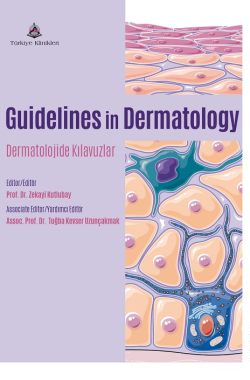SCABIES
Aslan Yürekli
Muğla Training and Research Hospital, Department of Dermatology, Muğla, Türkiye
Yürekli A. Scabies. In: Kutlubay Z, editor. Guidelines in Dermatology. 1st ed. Ankara: Türkiye Klinikleri; 2025. p.209-217.
ABSTRACT
Scabies is an ectoparasitic disease that can affect all segments of society, regardless of race, gender or age. In addition to being a medical problem, it can also cause social problems in patients. Patients may experience psychosocial problems along with a feeling of stigma. Itching, which increases at night and in the heat, is the main symptom of the disease. There are tunnels called cilion on the wrists and ankles and between the fingers. After the parasite reaches the body, it starts digging a tunnel within an average of 8 hours and lays its eggs in this tunnel. The mite that comes out of the tunnel to mate either digs a tunnel again or returns to its current tunnel after mating. Specific skin lesions are cilions, vesicle perle and nodular lesions frequently seen in the genital area. In addition to these, non-specific lesions such as excoriated papules and secondary bacterial infections can also be seen. Scabies lesions tend to frequently involve the anterior surface of the trunk. It tends to affect the area starting from the breast and including the inguinal region, also known as the Hebra circle, more frequently. Scabies does not affect the scalp and face except for immunosuppressed patients and infants. There are two main forms: classic and crusted scabies. While there are 8-20 mites in a patient with classic scabies, this number can increase to 1-2 million in patients with crusted scabies. Patients with crusted scabies have an uncontrolled proliferation of mites. Crusted scabies is more common in patients with immunosuppression, chronic renal failure, and down syndrome. Recently, there has been an increase in the frequency of scabies patients both in our country and around the world. The reasons for this increase are shown as irregular migration around the world and quarantines during the Covid-19 pandemic. However, it is a known fact that due to the nature of the disease, it causes epidemics at certain periods in history. Although some authors argue that this increase is due to the development of resistance to current treatments no resistance is shown at the molecular level and case series showing low treatment effectiveness are shared. In publications on treatment failure, it is emphasized that the most important reason for this failure is the patient or their relatives’ non-compliance with the treatment. The agent most accused of treatment failure is permethrin. However, when current guidelines are examined, it is observed that permethrin is still recommended in the first step. In this article, every aspect of scabies will be discussed in detail.
Keywords: Scabies; Parasitic diseases; Permethrin; Itch; Scabies outbreak
Kaynak Göster
Referanslar
- Mumcuoğlu K.Y, Taylan Özkan A, Gazi U. Uyuz Etkenin Entemolojik ve İmmunolojik Özellikleri. Uzun S, Durdu M, editör. Kongre Kitabevi: Her Yönüyle Uyuz. 1. Baskı. Ankara; 2023. p.21-25.
- Arlian LG, Morgan MS. A review of Sarcoptes scabiei: past, present and future. Parasit Vectors. 2017;10(1):297. [Crossref] [PubMed] [PMC]
- Golant AK, Levitt JO. Scabies: a review of diagnosis and management based on mite biology. Pediatr Rev. 2012;33(1):e1-e12. [Crossref] [PubMed]
- Richardson NA, Cassell JA, Head MG, Lanza S, Schaefer C, Walker SL, Middleton J. Scabies outbreak management in refugee/migrant camps in Europe 2014-2017: a retrospective qualitative interview study of healthcare staff experiences and perspectives. BMJ Open. 2023 Nov 8;13(11):e075103. [Crossref] [PubMed] [PMC]
- Şavk E. Uyuzda kaşıntının fizyopatolojisi. Uzun S, Durdu M, editör. Kongre Kitabevi: Her Yönüyle Uyuz. 1. Baskı. Ankara; 2023. p.77-79.
- Richards RN. Scabies: Diagnostic and Therapeutic Update. J Cutan Med Surg. 2021;25(1):95-101. [Crossref] [PubMed]
- Selvaraj R, Purushothaman S, Indra Couppoussamy K. Crusted scabies. Indian J Dermatol Venereol Leprol. Published online May 28, 2023. [Crossref] [PubMed]
- Yürekli A, Muslu İ, Pektaş SD, Alataş ET, Aydoğdu CT, Daşgin D. Using ultraviolet dermoscopy in diagnosing scabies. Exp Dermatol. 2023;32(11):1996-1999. [Crossref] [PubMed]
- Yürekli A. A new sign with UV dermoscope in the diagnosis of scabies: Ball sign. Skin Res Technol. 2023;29(5):e13336. [Crossref] [PubMed] [PMC]
- Yürekli A. How does Sarcoptes scabiei var. hominis meet its oxygen needs?. JAm Acad Dermatol. 2023;89(4):e161-e162. [Crossref] [PubMed]
- Yürekli A, Can İ, Oğuz M. Using ultraviolet light in diagnosing scabies: Scabies' Sign via Wood's Lamp. J Am Acad Dermatol. 2023;89(5):e195-e196. [Crossref] [PubMed]
- Mellanby K. Transmission of Scabies. Br Med J. 1941;2(4211):405-406. [Crossref] [PubMed] [PMC]
- Bernigaud C, Fischer K, Chosidow O. The Management of Scabies in the 21st Century: Past, Advances and Potentials. Acta Derm Venereol. 2020;100(9):adv00112. [Crossref] [PubMed] [PMC]
- Widaty S, Miranda E, Cornain EF, Rizky LA. Scabies: update on treatment and efforts for prevention and control in highly endemic settings. J Infect Dev Ctries. 2022;16(2):244-251. [Crossref] [PubMed]
- Özden MG, Ertürk K, Kartal SP, et al. An extraordinary outbreak of scabies in Turkey. J Eur Acad Dermatol Venereol. 2020;34(12):e818-e820. [Crossref] [PubMed]

